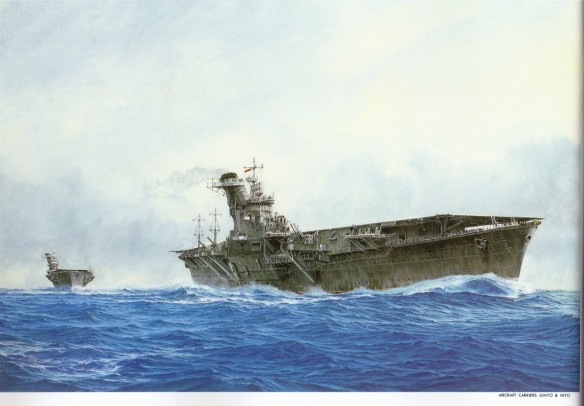
As war with the United States became increasingly probable, the Imperial Japanese Navy began to convert much of this “shadow” carrier fleet. It took over the Kashiwara Maru and its sister, the Izumo Maru, in October 1941 while they still were incomplete and converted them into the fleet carriers Junyo and Hiyo respectively. Since they had been completed only to the main deck, conversion work was rapid because there was little superstructure requiring prior removal, and both vessels commissioned within eight months. As front line units their principal deficiencies were slow speed, limited internal subdivision, and the absence of armor protection, but they otherwise compared quite favorably with purpose-built Japanese carriers.
The Kasuga Maru of the Nitta Maru class was still under construction when it was taken over on May 1, 1941, for conversion into the prototype Japanese escort carrier at Sasebo Navy Yard. This was a limited conversion involving clearing the hull to the upper deck, erecting a 300-foot long hangar topped by a 492-foot long flight deck, fitting two elevators, trunking the furnace uptakes to exhaust on the starboard side, and adding an antiaircraft battery. It commissioned some four months later as the Taiyo, and was followed by its two sisters the Yawata Maru and the Nitta Maru, which became the Unyo and the Chuyo respectively after six-month conversions at Kure Navy Yard. The two smaller OSK liners Argentina Maru and Brazil Maru also were slated for similar conversions in late 1942 but in the event only the former commissioned as the escort carrier Taiyo because the Brazil Maru was sunk while serving as a troopship before conversion could begin. In its place the ex- German Norddeutscher Line liner Scharnhorst, which had been trapped at Kobe by the outbreak of war in Europe and taken over by Japan in early 1942, was similarly converted into the escort carrier Shinyo during 1943. The three Asama Maru class liners, the original group of subsidized “shadow” carriers, never converted into aircraft carriers because all were sunk while serving as naval transports.
The original intent of the subsidy program was to expedite expansion of the front-line carrier fleet. Although the Japanese escort carriers were much larger than their British and American counterparts, they were too slow, small, and weakly-armed for front-line operations. Within Japanese fleet doctrine there was no real place for the escort carriers either, since the Imperial Japanese Navy did not develop a coherent policy for deploying antisubmarine forces until very late in the war. Consequently, the escort carrier conversions spent almost their entire careers operating as aircraft transports and training carriers. Only the larger, faster, and very much more sophisticated conversions Hiyo and Junyo fulfilled the promise of the “shadow” program.